
Ladakh is a region administered by India as a union territory and constitutes an eastern portion of the larger Kashmir region that has been the subject of a dispute between India and Pakistan since 1947 and India and China since 1959. Ladakh is bordered by the Tibet Autonomous Region to the east, the Indian state of Himachal Pradesh to the south, both the Indian-administered union territory of Jammu and Kashmir and the Pakistan-administered Gilgit-Baltistan to the west, and the southwest corner of Xinjiang across the Karakoram Pass in the far north. It extends from the Siachen Glacier in the Karakoram range to the north to the main Great Himalayas to the south. The eastern end, consisting of the uninhabited Aksai Chin plains, is claimed by the Indian Government as part of Ladakh, but has been under Chinese control.

Leh is a city in Indian Union Territory of Ladakh in the disputed Kashmir region. It is the capital of Ladakh since medieval age. Leh, located in the Leh district, was also the historical capital of the Kingdom of Ladakh. The seat of the kingdom, Leh Palace, the former residence of the royal family of Ladakh, was built in the same style and about the same time as the Potala Palace in Tibet. Since they were both constructed in a similar style and at roughly the same time, the Potala Palace in Tibet and Leh Palace, the royal residence, are frequently contrasted. Leh is at an altitude of 3,524 m (11,562 ft), and is connected via National Highway 1 to Srinagar in the southwest and to Manali in the south via the Leh-Manali Highway.

Kargil district is a district in Indian-administered Ladakh in the disputed Kashmir-region, which is administered as a union territory of Ladakh. It is named after the city of Kargil, where the district headquarters lies. The district is bounded by the Indian-administered union territory of Jammu and Kashmir to the west, the Pakistani-administered administrative territory of Gilgit–Baltistan to the north, Ladakh's Leh district to the east, and the Indian state of Himachal Pradesh to the south. Encompassing three historical regions known as Purig, Dras and Zanskar, the district lies to the northeast of the Great Himalayas and encompasses the majority of the Zanskar Range. Its population inhabits the river valleys of the Dras, Suru, Wakha Rong, and Zanskar.
The Ladakhi language is a Tibetic language spoken in the Indian union territory of Ladakh. It is the predominant language in the Buddhist-dominated district of Leh, and a minority language in the district of Kargil. Though a member of the Tibetic family, Ladakhi is not mutually intelligible with Standard Tibetan. Ladakhis and Tibetans usually communicate with each other in Hindi or English as they do not understand each other's languages clearly.
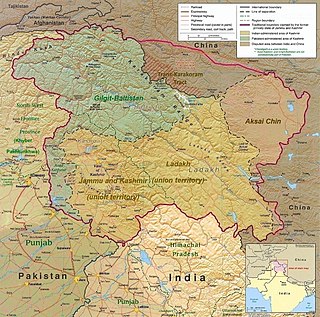
Ladakh has a long history with evidence of human settlement from as back as 9000 b.c. It has been a crossroad of high Asia for thousands of years and has seen many cultures, empires and technologies born in its neighbours. As a result of these developments Ladakh has imported many traditions and culture from its neighbours and combining them all gave rise to a unique tradition and culture of its own.

The Ladakh Autonomous Hill Development Council, Leh is one among the two Autonomous District Council of Ladakh Union Territory. LAHDC Leh administers the Leh district of Ladakh, India.
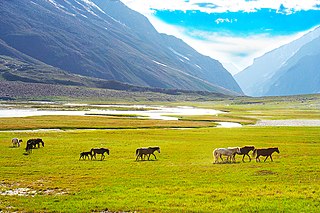
The Suru Valley is a valley in the Kargil District in the Union Territory of Ladakh, India. It is drained by the Suru River, a tributary of the Indus River. The valley's most significant town is Sankoo.

The Ladakh Range is a mountain range in central Ladakh in India with its northern tip extending into Baltistan in Pakistan. It lies between the Indus and Shyok river valleys, stretching to 230 miles (370 km). Leh, the capital city of Ladakh, is on the foot of Ladakh Range in the Indus river valley.
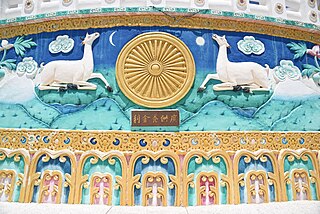
Ladakh Buddhist Association (LBA) is an organization in Ladakh, India concerned with interests of Buddhists in Ladakh. It was founded in 1933 by King Jigmet Dadul Namgyal, Kalon Tsewang Rigzin, lachumir Munshi Sonam Tsewang and Kalon Bankapa Morup Gyaltsan
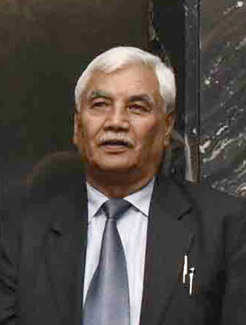
Thupstan Chhewang is an Indian politician who was a member of the 14th and 16th Lok Sabha representing the Ladakh constituency in the former state of Jammu and Kashmir.

Lingshed Monastery or Lingshed Gompa is a Gelugpa Buddhist monastery in Ladakh, India. It is located near Lingshet village in the Leh district. It is 84 km north of Padum. It was founded in the 1440s by Changsems Sherabs Zangpo, disciple of Je Tsongkhapa, on a monastic site previously founded by the Translator Rinchen Zangpo. The monastery has belonged to the religious estate of Ngari Rinpoche since 1779. The Jangchub Tensung Dorje Center was founded in Lingshed by Kyabje Dagom Rinpoche in 1994.
Tsering Samphel is an Indian politician. Samphel supports the demand to give Ladakh Union Territory status.

Eliezer Joldan (1916-2001) was the first trained graduate to profess teaching as a profession in Ladakh. He was born in 1916 to Jonathan Tharchin Joldan and Chamnyet. He got his bachelor's degree in education from the Punjab University, Lahore. He died at the age of 85 at Leh. The Govt. Degree College at Leh is named after him. His students includes top political leaders, doctors, scholars and other intelligentsia of Ladakh on 23 June 2001. He would always prefer the traditional Ladakhi Goncha over western pants and shirts.

Kacho Sikander Khan Sikander (1917-2007) was an eminent Indian writer from Kargil District of Ladakh. His work Qadeem Ladakh - Tarikh-o-Tamaddun is a major study of the history of Ladakh from the time people settled in the region up to the post-independent era.
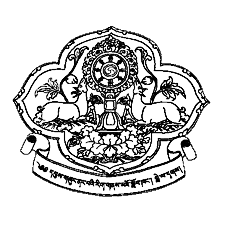
The Central Institute of Buddhist Studies, formerly known as the School of Buddhist Philosophy, located in Leh town of Ladakh is a deemed university under Ministry of Culture. It was founded in 1959 and formerly affiliated to the Sampurnanand Sanskrit University in Varanasi.
Tangtse or Drangtse (Tibetan: བྲང་རྩེ, Wylie: brang rtse, THL: drang tsé) is a village in the Leh district of Ladakh, India. It is located in the Durbuk tehsil. Traditionally, it was regarded as the border between the Nubra region to the north and the Pangong region to the south. It was a key halting place on the trade route between Turkestan and Tibet. It was also a site of wars between Ladakh and Tibet.

Sonam Wangchuk is an Indian engineer, innovator and education reformist. He is the founding-director of the Students' Educational and Cultural Movement of Ladakh (SECMOL), which was founded in 1988 by a group of students who had been in his own words, the 'victims' of an alien education system foisted on Ladakh. He is also known for designing the SECMOL campus that runs on solar energy and uses no fossil fuels for cooking, lighting or heating.
Chering Dorjay is an Indian politician and was a member of the Bharatiya Janata Party. Dorjay was a member of the Jammu and Kashmir Legislative Council from the Assembly Kashmir (Ladakh). He was Minister for Cooperatives and Ladakh Affairs in Jammu and Kashmir till 19 June 2018.
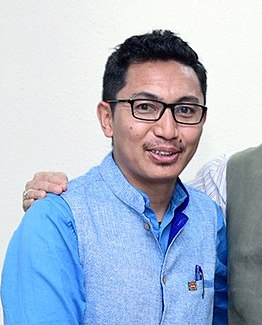
Jamyang Tsering Namgyal, also known by his initials JTN, is an Indian politician who served as a Member of Parliament in Lok Sabha for Ladakh, India's largest parliamentary seat geographically. Namgyal was elected, on 9 November 2018, to be the youngest and 8th Chief Executive Councillor (CEC) of Ladakh Autonomous Hill Development Council, Leh. He belongs to the Bharatiya Janata Party (BJP). and now he is currently not serving member of parliament.

The culture of Ladakh refers to the traditional customs, belief systems, and political systems that are followed by Ladakhi people in India. The languages, religions, dance, music, architecture, food, and customs of the Ladakh region are similar to neighboring Tibet. Ladakhi is the traditional language of Ladakh. The popular dances in Ladakh include the khatok chenmo, cham, etc. The people of Ladakh also celebrate several festivals throughout the year, some of the me Hemis Tsechu and Losar.


















